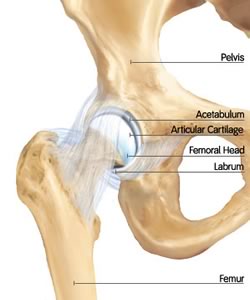Anatomy and Function of the Hip
 The hip, a ball-and-socket joint, is the largest weight-bearing joint in the body. When the joint is healthy, the head of the femur (thighbone) forms a round ball that fits into the acetabulum, a cavity at the base of the pelvis that forms the socket.
The hip, a ball-and-socket joint, is the largest weight-bearing joint in the body. When the joint is healthy, the head of the femur (thighbone) forms a round ball that fits into the acetabulum, a cavity at the base of the pelvis that forms the socket.
Ligaments connect the ball to the socket and keep them both firmly supported. The surfaces of the femoral head and the acetabulum are covered by a smooth, tough material known as articular cartilage, which cushions the bones and allows them to move easily. Around the rim of the acetabulum is a layer of fibrous cartilage called the labrum, which deepens the socket and provides a suction seal to hold the head of the femur firmly in place.
The other surfaces of the hip joint are covered by a thin, smooth tissue liner called the synovial membrane. This tissue produces a small amount of synovial fluid that acts as a lubricant and reduces the amount of friction that occurs when the bones move against each other.
Last Modified: November 5, 2020